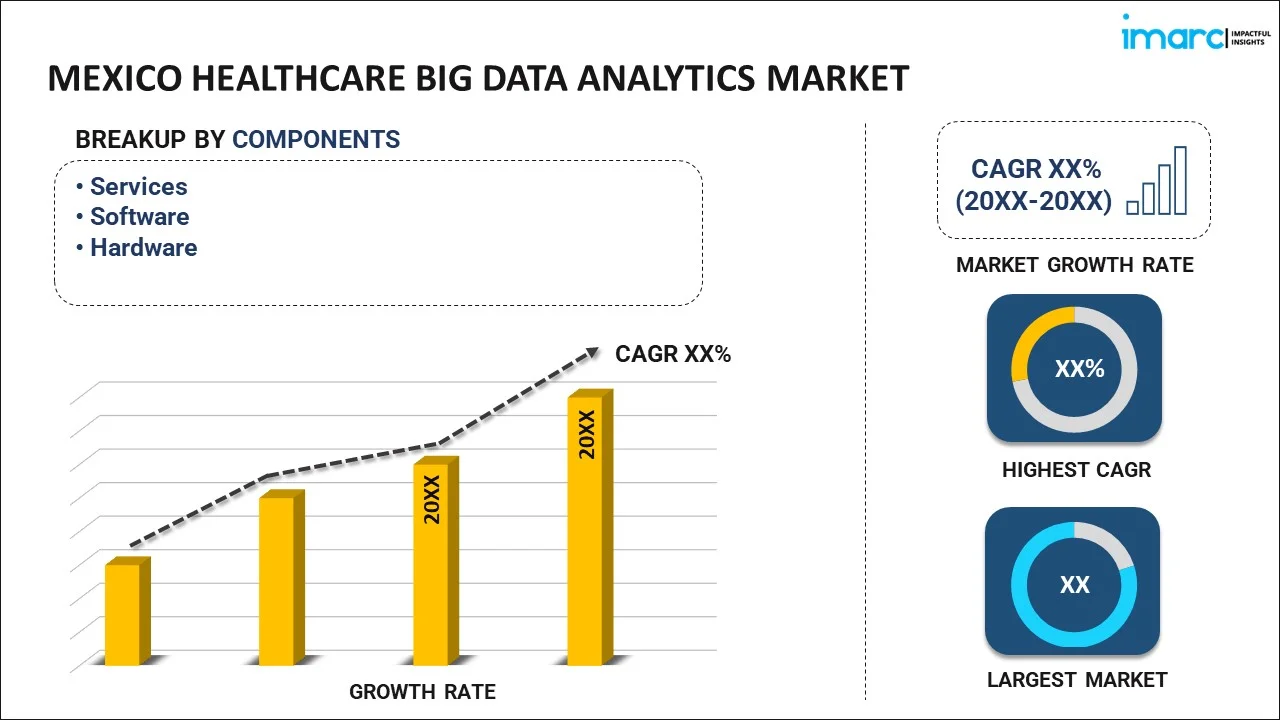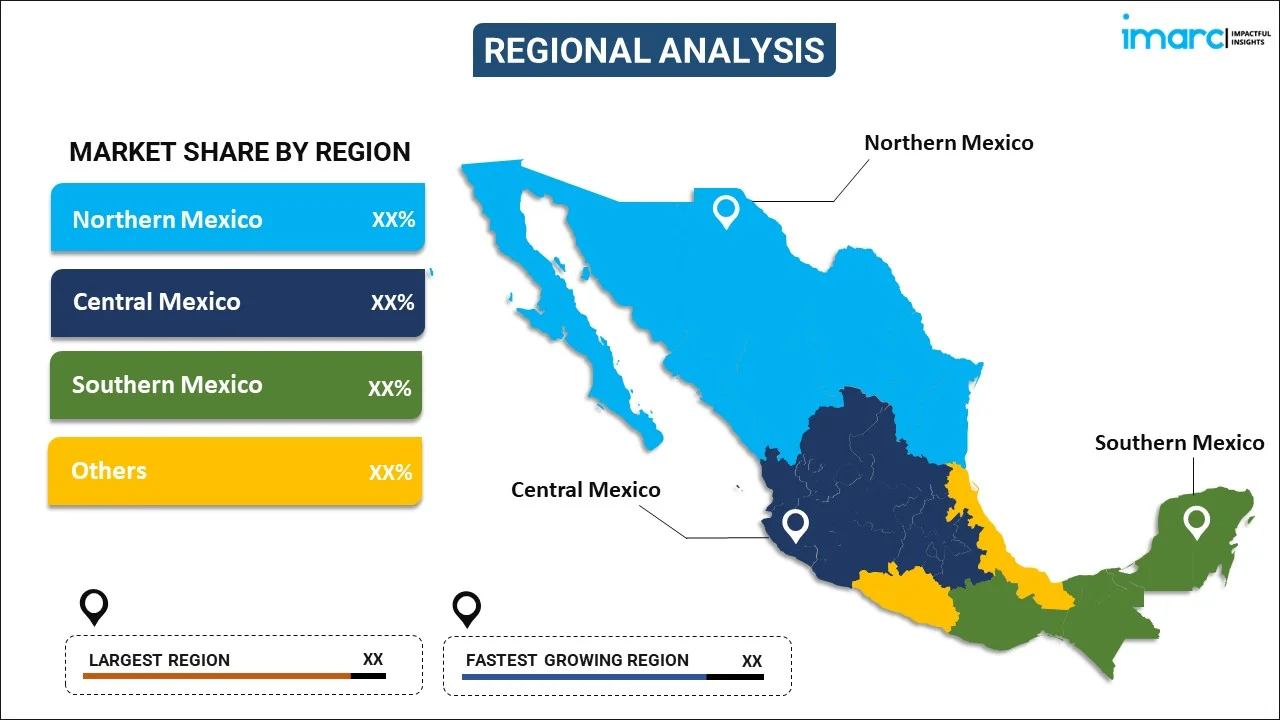
Mexico Healthcare Big Data Analytics Market Report by Component (Services, Software, Hardware), Analytics Type (Descriptive Analytics, Predictive Analytics, Prescriptive Analytics, Cognitive Analytics), Delivery Model (On-premises Delivery Model, On-Demand Delivery Model), Application (Financial Analytics, Clinical Analytics, Operational Analytics, and Others), End User (Hospitals and Clinics, Finance and Insurance Agencies, Research Organizations), and Region 2025-2033
Market Overview:
Mexico healthcare big data analytics market size reached USD 836.6 Million in 2024. Looking forward, IMARC Group expects the market to reach USD 4,220.3 Million by 2033, exhibiting a growth rate (CAGR) of 18.4% during 2025-2033. The emerging popularity of predictive models across the country to minimize inefficiencies in clinical operations, public healthcare, and R&D activities is primarily driving the market growth.
|
Report Attribute
|
Key Statistics
|
|---|---|
|
Base Year
|
2024
|
|
Forecast Years
|
2025-2033
|
|
Historical Years
|
2019-2024
|
|
Market Size in 2024
|
USD 836.6 Million |
|
Market Forecast in 2033
|
USD 4,220.3 Million |
| Market Growth Rate 2025-2033 | 18.4% |
Healthcare big data analytics involves the systematic analysis of vast and complex datasets to extract meaningful insights and improve decision-making processes in the medical field. This practice integrates advanced technologies, statistical models, and data management techniques to uncover patterns, trends, and correlations within healthcare information. By processing and interpreting large volumes of structured and unstructured data, professionals can enhance patient outcomes, optimize resource allocation, streamline operational efficiency, etc. Big data analytics in healthcare encompasses various aspects, including clinical analytics, predictive analytics, population health management, etc. It enables healthcare providers to identify high-risk patients, predict disease outbreaks, and personalize treatment plans. Ultimately, healthcare big data analytics plays a pivotal role in transforming healthcare delivery, fostering evidence-based practices, advancing the overall quality and effectiveness of patient care, etc.
Mexico Healthcare Big Data Analytics Market Trends:
The Mexico healthcare big data analytics market is witnessing substantial growth, propelled by several key drivers. Firstly, the increasing digitization of healthcare records and the widespread adoption of electronic health records (EHRs) have generated vast datasets, thereby augmenting the market growth. This digital transformation enhances data accessibility, enabling healthcare professionals to harness valuable insights for informed decision-making. Moreover, the growing focus on precision medicine and personalized healthcare is acting as another significant growth-inducing factor. Apart from this, big data analytics facilitates the analysis of diverse patient data sets, aiding in the identification of individualized treatment plans and improving overall healthcare outcomes. Additionally, the rising prevalence of chronic diseases has heightened the need for effective data-driven strategies in healthcare management, which is also stimulating the market growth in Mexico. Furthermore, government initiatives and regulatory support across the country play a crucial role in driving the adoption of big data analytics in healthcare. In line with this, policies that encourage interoperability and data sharing contribute to a collaborative healthcare ecosystem. Moreover, the increasing focus on enhanced patient care is expected to fuel the market growth over the forecasted period.
Mexico Healthcare Big Data Analytics Market Segmentation:
IMARC Group provides an analysis of the key trends in each segment of the market, along with forecasts at the country level for 2025-2033. Our report has categorized the market based on component, analytics type, delivery model, application, and end user.
Component Insights:

- Services
- Software
- Electronic Health Record Software
- Practice Management
- Workforce Management
- Hardware
- Data Storage
- Routers
- Firewalls
- Virtual Private Networks
- E-Mail Servers
- Others
The report has provided a detailed breakup and analysis of the market based on the component. This includes services, software (electronic health record software, practice management, and workforce management), and hardware (data storage, routers, firewalls, virtual private networks, e-mail servers, and others).
Analytics Type Insights:
- Descriptive Analytics
- Predictive Analytics
- Prescriptive Analytics
- Cognitive Analytics
A detailed breakup and analysis of the market based on the analytics type have also been provided in the report. This includes descriptive analytics, predictive analytics, prescriptive analytics, and cognitive analytics.
Delivery Model Insights:
- On-premises Delivery Model
- On-Demand Delivery Model
The report has provided a detailed breakup and analysis of the market based on the delivery model. This includes on-premises delivery model and on-demand delivery model.
Application Insights:
- Financial Analytics
- Clinical Analytics
- Operational Analytics
- Others
A detailed breakup and analysis of the market based on the application have also been provided in the report. This includes financial analytics, clinical analytics, operational analytics, and others.
End User Insights:
- Hospitals and Clinics
- Finance and Insurance Agencies
- Research Organizations
The report has provided a detailed breakup and analysis of the market based on the end user. This includes hospitals and clinics, finance and insurance agencies, and research organizations.
Regional Insights:

- Northern Mexico
- Central Mexico
- Southern Mexico
- Others
The report has also provided a comprehensive analysis of all the major regional markets, which include Northern Mexico, Central Mexico, Southern Mexico, and Others.
Competitive Landscape:
The market research report has also provided a comprehensive analysis of the competitive landscape. Competitive analysis such as market structure, key player positioning, top winning strategies, competitive dashboard, and company evaluation quadrant has been covered in the report. Also, detailed profiles of all major companies have been provided.
Mexico Healthcare Big Data Analytics Market Report Coverage:
| Report Features | Details |
|---|---|
| Base Year of the Analysis | 2024 |
| Historical Period | 2019-2024 |
| Forecast Period | 2025-2033 |
| Units | Million USD |
| Scope of the Report | Exploration of Historical Trends and Market Outlook, Industry Catalysts and Challenges, Segment-Wise Historical and Future Market Assessment:
|
| Components Covered |
|
| Analytics Types Covered | Descriptive Analytics, Predictive Analytics, Prescriptive Analytics, Cognitive Analytics |
| Delivery Models Covered | On-premises Delivery Model, On-Demand Delivery Model |
| Applications Covered | Financial Analytics, Clinical Analytics, Operational Analytics, Others |
| End Users Covered | Hospitals and Clinics, Finance and Insurance Agencies, Research Organizations |
| Regions Covered | Northern Mexico, Central Mexico, Southern Mexico, Others |
| Customization Scope | 10% Free Customization |
| Post-Sale Analyst Support | 10-12 Weeks |
| Delivery Format | PDF and Excel through Email (We can also provide the editable version of the report in PPT/Word format on special request) |
Key Questions Answered in This Report:
- How has the Mexico healthcare big data analytics market performed so far and how will it perform in the coming years?
- What has been the impact of COVID-19 on the Mexico healthcare big data analytics market?
- What is the breakup of the Mexico healthcare big data analytics market on the basis of component?
- What is the breakup of the Mexico healthcare big data analytics market on the basis of analytics type?
- What is the breakup of the Mexico healthcare big data analytics market on the basis of delivery model?
- What is the breakup of the Mexico healthcare big data analytics market on the basis of application?
- What is the breakup of the Mexico healthcare big data analytics market on the basis of end user?
- What are the various stages in the value chain of the Mexico healthcare big data analytics market?
- What are the key driving factors and challenges in the Mexico healthcare big data analytics?
- What is the structure of the Mexico healthcare big data analytics market and who are the key players?
- What is the degree of competition in the Mexico healthcare big data analytics market?
Key Benefits for Stakeholders:
- IMARC’s industry report offers a comprehensive quantitative analysis of various market segments, historical and current market trends, market forecasts, and dynamics of the Mexico healthcare big data analytics market from 2019-2033.
- The research report provides the latest information on the market drivers, challenges, and opportunities in the Mexico healthcare big data analytics market.
- Porter's five forces analysis assist stakeholders in assessing the impact of new entrants, competitive rivalry, supplier power, buyer power, and the threat of substitution. It helps stakeholders to analyze the level of competition within the Mexico healthcare big data analytics industry and its attractiveness.
- Competitive landscape allows stakeholders to understand their competitive environment and provides an insight into the current positions of key players in the market.
Need more help?
- Speak to our experienced analysts for insights on the current market scenarios.
- Include additional segments and countries to customize the report as per your requirement.
- Gain an unparalleled competitive advantage in your domain by understanding how to utilize the report and positively impacting your operations and revenue.
- For further assistance, please connect with our analysts.
 Request Customization
Request Customization
 Speak to an Analyst
Speak to an Analyst
 Request Brochure
Request Brochure
 Inquire Before Buying
Inquire Before Buying




.webp)




.webp)












